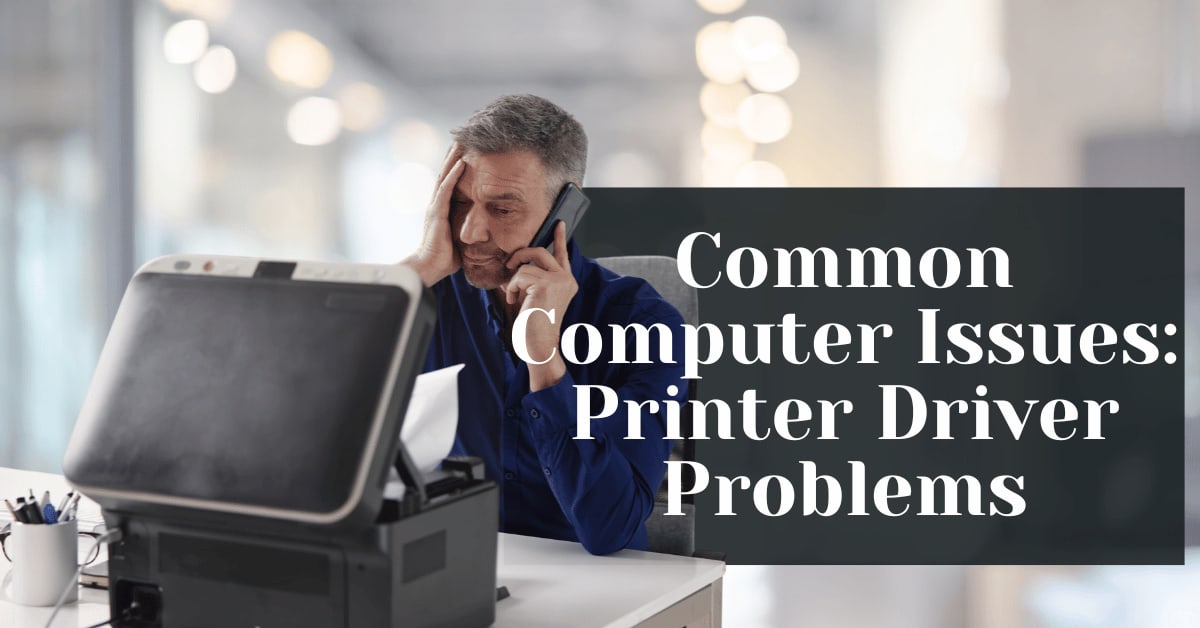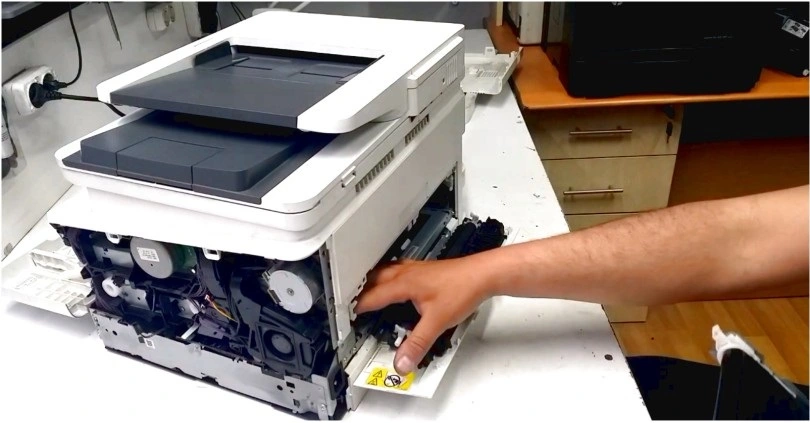Introduction
Laser printers are known for their high-quality prints and fast speeds, making them a popular choice for both home and office environments. However, like any piece of technology, laser printers can sometimes experience issues that disrupt your printing tasks. Whether you’re dealing with paper jams, poor print quality, or connectivity problems, these issues can halt your workflow and cause frustration.

In this blog, we’ll walk you through common laser printer problems and provide effective solutions to fix them. By following our troubleshooting guide, you can quickly address issues and get your laser printer back to optimal performance.
1. Paper Jams in Laser Printers
One of the most frequent laser printer problems is paper jams. They occur when the paper gets stuck inside the printer during the printing process, causing the job to be interrupted.
How to Solve Paper Jams:
- Turn Off the Printer: Always turn off the printer and unplug it before trying to fix a paper jam.
- Open the Printer Covers: Open the front and rear covers of the printer to locate the jammed paper.
- Gently Remove the Paper: Carefully pull out the stuck paper in the direction of the paper path. Avoid tearing the paper as you pull it out.
- Inspect for Small Fragments: Check for any small bits of paper left inside and remove them.
- Clean the Rollers: Dust and debris on the rollers can cause paper jams. Clean the rollers with a lint-free cloth.
Preventing Paper Jams:
- Ensure you use the right type of paper and load it properly into the tray.
- Keep the paper clean and free from moisture.
- Regularly clean the printer’s rollers and interior.
2. Poor Print Quality
Laser printers are designed for sharp, crisp prints, but poor print quality can sometimes occur, causing blurry or faded documents.
How to Solve Poor Print Quality:
- Check the Toner Cartridge: Ensure the toner cartridge is not low or empty. Replace it if necessary.
- Run a Cleaning Cycle: Most laser printers have a built-in cleaning function to clear the printhead or toner.
- Replace the Drum Unit: If the print quality is still poor, the drum unit may be worn out and needs replacement.
- Adjust Printer Settings: Ensure your printer settings are set to print in high-quality mode. Check for any settings that may be causing poor results.

Preventing Poor Print Quality:
- Use high-quality toner cartridges that are compatible with your printer model.
- Clean your printer regularly to avoid toner buildup.
- Use the correct paper for your specific printer to avoid smudging.
3. Laser Printer Won’t Print
If your laser printer refuses to print, there may be several reasons for the problem, such as a software issue, hardware malfunction, or connectivity error.
How to Solve Printer Not Printing:
- Check the Power and Connections: Ensure that the printer is turned on and connected to your computer or network.
- Clear the Print Queue: Sometimes, a stuck print job in the queue can prevent other documents from printing. Clear the print queue and try again.
- Check for Errors: If your printer’s display shows an error, consult the user manual to resolve the issue.
- Reinstall Printer Drivers: Outdated or corrupted printer drivers can cause printing issues. Download and install the latest drivers from the manufacturer’s website.
Preventing Printing Issues:
- Regularly update your printer drivers to avoid software-related problems.
- Avoid overloading the printer with too many print jobs at once.
- Use the printer’s built-in maintenance tools to keep it running smoothly.

4. Laser Printer Printing Blank Pages
Printing blank pages instead of the desired content can be caused by several issues, such as an empty toner cartridge, clogged printheads, or an incorrect printer setting.
How to Solve Blank Pages Printed:
- Check Toner Levels: Verify that the toner cartridge is not empty or low on toner. Replace it if necessary.
- Run the Cleaning Utility: Use the printer’s cleaning function to clear any clogged printheads.
- Check the Printer Settings: Ensure that the print job is not set to print blank pages or drafts.
- Replace the Drum Unit: If the drum unit is worn out, it may be unable to transfer toner to the paper properly.
Preventing Blank Pages:
- Replace toner cartridges before they run out completely.
- Run printhead cleaning cycles regularly to prevent clogs.
- Use high-quality toner that is compatible with your laser printer.
5. Printer Showing “Offline” or “Not Responding”
When your laser printer shows as “offline” or “not responding,” it may be due to a communication issue between your printer and the computer or network.
How to Solve Printer Offline:
- Check the Printer’s Connection: Ensure that the printer is properly connected to your computer or network. If it’s a wireless printer, check the Wi-Fi connection.
- Set Printer to Default: Make sure the laser printer is set as the default printer on your computer.
- Restart Both Devices: Restart both the printer and your computer to resolve any communication issues.
- Reinstall Printer Drivers: If the issue persists, reinstall the printer drivers to fix any connectivity problems.
Preventing Connectivity Issues:
- Keep the printer’s firmware up to date.
- Regularly check network connections and settings.
- Avoid too many devices connected to the same network, as this can slow down communication.

6. Laser Printer Not Feeding Paper Properly
Paper feeding problems can occur when the printer fails to pick up the paper correctly, causing print jobs to fail or paper to be misaligned.
How to Solve Paper Feeding Issues:
- Adjust the Paper Guides: Ensure the paper guides in the tray are properly aligned to the paper size you are using.
- Clean the Rollers: Dust and debris can prevent the rollers from properly grabbing the paper. Clean the rollers with a lint-free cloth.
- Check the Paper Type: Make sure the paper you are using is compatible with your laser printer. Paper that’s too thick or thin can cause feeding issues.
Preventing Paper Feeding Problems:
- Keep the paper clean and dry to prevent feed issues.
- Use the right paper size and weight for your printer.
- Regularly clean the paper rollers to prevent dust buildup.
7. Overheating Printer
If your laser printer is overheating, it may shut down or produce poor-quality prints.
How to Solve Printer Overheating:
- Allow the Printer to Cool Down: If the printer becomes too hot, turn it off and let it cool down before using it again.
- Ensure Proper Ventilation: Place the printer in a well-ventilated area to prevent overheating.
- Check for Dust and Obstructions: Dust buildup inside the printer can block air circulation, leading to overheating. Clean the interior of the printer.

Preventing Overheating:
- Avoid running long print jobs without breaks.
- Keep the printer in a cool, dry environment.
- Regularly clean the printer’s internal components.
8. Laser Printer Making Unusual Noises
Unusual noises, such as grinding or clicking, can be a sign of a mechanical issue or internal obstruction in your laser printer.
How to Solve Noisy Printer:
- Check for Obstructions: Look inside the printer for any paper scraps or debris that could be causing the noise.
- Inspect the Rollers: Worn-out or dirty rollers can cause grinding noises. Clean or replace the rollers if needed.
- Check for Loose Parts: Ensure that all internal parts are securely in place. Tighten any loose components.
Preventing Noisy Printers:
- Regularly clean the printer to avoid dust and debris buildup.
- Replace worn-out rollers and other mechanical components.
- Perform routine maintenance on your printer.
Conclusion Of Common Laser Printer Problems
Laser printers are powerful tools that offer excellent print quality and fast speeds, but like any device, they can encounter problems. By understanding the common laser printer problems and how to fix them, you can troubleshoot issues quickly and get back to printing without unnecessary delays.
If you’re experiencing persistent problems that you can’t resolve, Integral Systems offers expert support to help. Our team of professionals is ready to assist with any printer or IT issues you may have. For more information or personalized help, feel free to contact us.
Need Help with Printer Issues? Contact Integral Systems for Expert Support!
Visit our website: www.insystemtech.com
Address: 1201 West Esplanade Ave Apt. 303, LA, Kenner, United States 70065
Email: admin@integralsystems.us
Phone: +1 888 5065 226
We also provide Managed IT Support services powered by Argusdna. Learn more at Argusdna.


